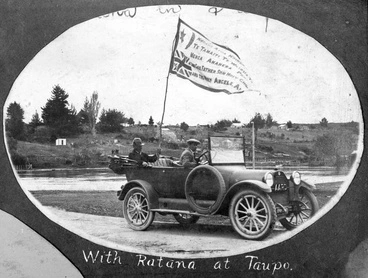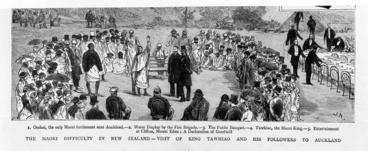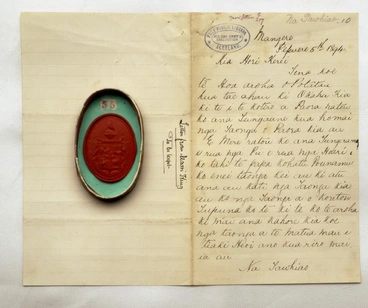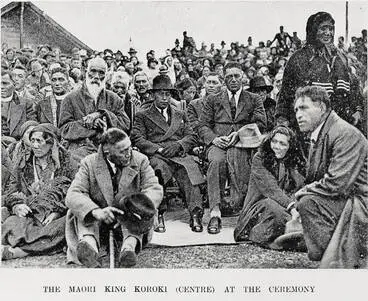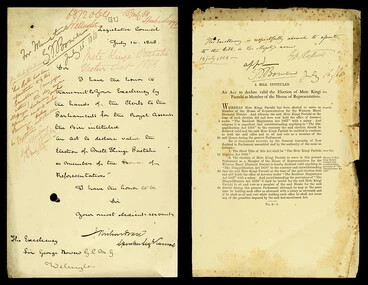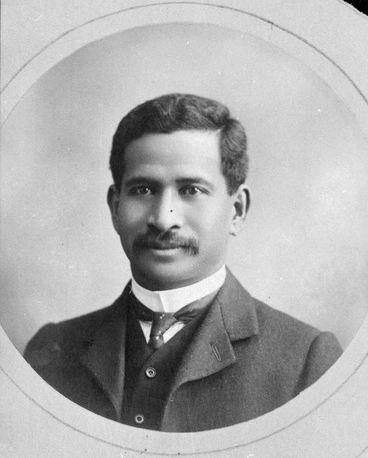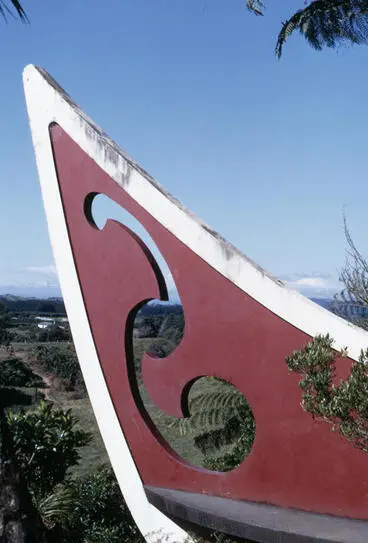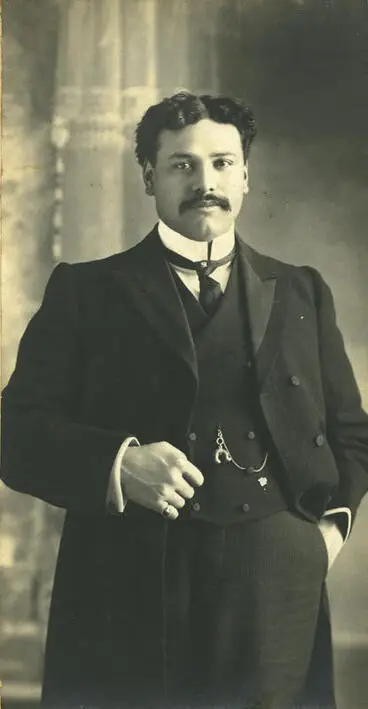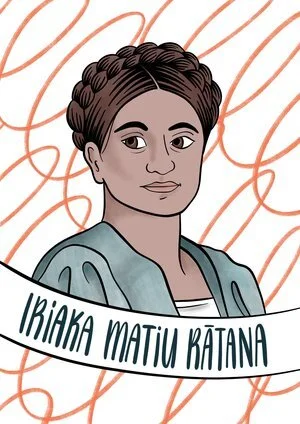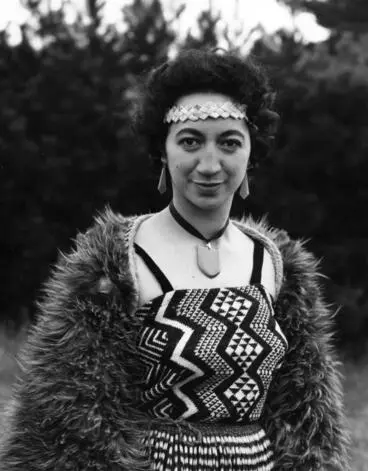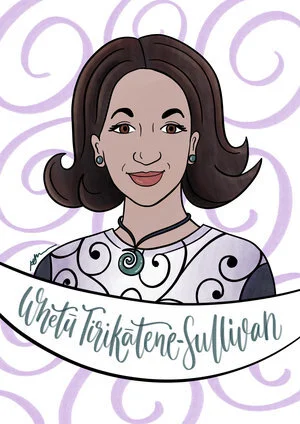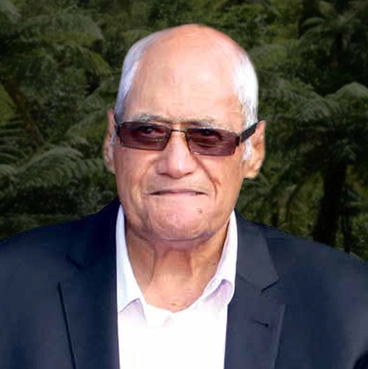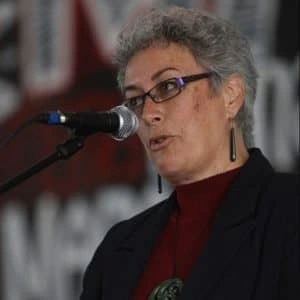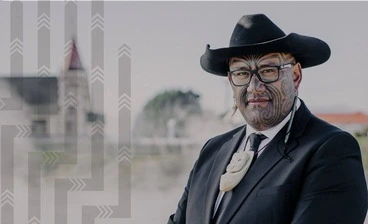Māori political movements and changemakers
A DigitalNZ Story by National Library Services to Schools
This story provides links to resources about some of New Zealand's Māori political movements and changemakers.
POLITICAL MOVEMENTS
In 1867 four new electorates were created specifically for Māori, who would only be able to vote in these electorates. Likewise, Māori candidates could stand only in Māori electorates, unless they had one non-Māori parent and then they could stand in either a Māori or a general electorate.
The 20th century saw the emergence of several new Māori political parties. However, it was not until 1967 that the National government changed the law to allow Māori to stand in European electorates, and only in 1975 did Māori gain the choice to enrol either on the Māori or the general electoral roll.
Source: Tōrangapū – Māori and political parties, Te Ara — the Encyclopedia of New Zealand
Repudiation movement
Manatū Taonga, the Ministry for Culture and Heritage
Rātana on the road
Manatū Taonga, the Ministry for Culture and Heritage
Kotahitanga newspaper mastheads
Manatū Taonga, the Ministry for Culture and Heritage
Young Māori Party
Manatū Taonga, the Ministry for Culture and Heritage
Mana Motuhake
Auckland War Memorial Museum Tāmaki Paenga Hira
Māori Party
Manatū Taonga, the Ministry for Culture and Heritage
KIINGITANGA - MĀORI KING MOVEMENT
The Kiingitanga (Māori King movement) is one of New Zealand’s longest-standing political institutions. Founded in 1858, it continued in the 2000s.Traditionally Māori had no centralised monarchy. Tribes were independent and were led by chiefs.In the 1850s there were growing numbers of European settlers and demand for Māori land, and Māori lacked political power. Some Māori wanted to unify the tribes under a sovereign.
In 1853 Mātene Te Whiwhi and Tāmihana Te Rauparaha began travelling round the North Island looking for a chief who would agree to become king. However, most chiefs declined.
Source: Tōrangapū – Māori and political parties, Te Ara — the Encyclopedia of New Zealand
King movement flags
Manatū Taonga, the Ministry for Culture and Heritage
In 1856, at Pūkawa, on the shores of Lake Taupō, the Waikato chief Pōtatau Te Wherowhero was nominated as king. At first he refused, but later agreed. In 1858 he was declared king at Ngāruawāhia.
Source: Tōrangapū – Māori and political parties, Te Ara — the Encyclopedia of New Zealand
The Palace Ngaruawahia N.Z.
Auckland War Memorial Museum Tāmaki Paenga Hira
Kīngitanga flags: Mahuta's flag
Manatū Taonga, the Ministry for Culture and Heritage
Pōtatau died in 1860 and his son, Tāwhiao, became king. In 1863 government troops invaded the Waikato, and war followed. Waikato were defeated, huge areas of their land were confiscated, and Tāwhiao and his followers retreated into the King Country. In 1881 they returned to Waikato. Tāwhiao worked unsuccessfully for the return of confiscated lands, and travelled to London in 1884 to look for support from Queen Victoria.
Tāwhiao set up the Kauhanganui (Kīngitanga parliament) and began poukai (annual visits to Kīngitanga marae).
Source: Tōrangapū – Māori and political parties, Te Ara — the Encyclopedia of New Zealand
King movement £1 note
Manatū Taonga, the Ministry for Culture and Heritage
Letter to Sir George Grey from King Tawhiao with Tawhiao's seal
Auckland Libraries
Mahuta became king in 1890 after the death of Tāwhiao, his father. In the 1890s the Kīngitanga tried unsuccessfully to unite with the Kotahitanga (Māori parliament) movement. From 1903 to 1910 Mahuta was a member of the Legislative Council, appointed by Premier Richard Seddon.
Source: Tōrangapū – Māori and political parties, Te Ara — the Encyclopedia of New Zealand
King Mahuta
Manatū Taonga, the Ministry for Culture and Heritage
Mahuta died in 1912 and his son, Te Rata, became king. Te Rata was often ill. In 1914 he and three others travelled to England. He met King George V, but was told that the land confiscations were an issue for the New Zealand government.
Source: Tōrangapū – Māori and political parties, Te Ara — the Encyclopedia of New Zealand
Te Rata’s cousin, Te Puea Hērangi, became a Kīngitanga leader. She opposed participation in the First World War, and worked to rebuild an economic base and to establish Tūrangawaewae marae at Ngāruawāhia.
Source: Tōrangapū – Māori and political parties, Te Ara — the Encyclopedia of New Zealand
Korokī reluctantly became king in 1933 after his father, Te Rata, died. At Tūrangawaewae he hosted important visitors, including Queen Elizabeth II in 1953.
Source: Tōrangapū – Māori and political parties, Te Ara — the Encyclopedia of New Zealand
The Māori King Koroki (centre) at the ceremony
Auckland Libraries
After Korokī died in 1966, his daughter, Piki, was crowned as Queen Te Atairangikaahu, the first Māori queen. She was made a dame in 1970. One of the most important achievements during her reign was when Tainui–Waikato signed a settlement with the government in 1995 over the land confiscations. Te Atairangikaahu died in August 2006. She was the longest-serving Māori monarch.
Source: Tōrangapū – Māori and political parties, Te Ara — the Encyclopedia of New Zealand
Coronation of Te Atairangikaahu, 1966
Manatū Taonga, the Ministry for Culture and Heritage
Te Atairangikaahu’s son Tūheitia became king in 2006.
Source: Tōrangapū – Māori and political parties, Te Ara — the Encyclopedia of New Zealand
King Tūheitia
Manatū Taonga, the Ministry for Culture and Heritage
MORE POLITICAL CHANGEMAKERS
The first Māori members of Parliament took their seats in 1868. They were Frederick Nene Russell, Mete Kīngi Te Rangi Paetahi, Tāreha Te Moananui and John Patterson.
In the late 19th and early 20th centuries better-educated, younger Māori entered Parliament, including James Carroll, Hirini Taiwhanga, Hōne Heke Ngapua, Apirana Ngata, Te Rangihīroa (Peter Buck) and Māui Pōmare. They could hold their own with European MPs, and used the parliamentary system with great skill.
From 1896 Māori (except half-castes) were not allowed to stand as candidates in general seats. The law was changed in 1967, but it was not until 1975 that Māori were successful in general electorates.
In 1993 a revised Māori electoral option meant that the number of Māori seats was again based on the numbers registering on the Māori roll. A fifth Māori seat was added in time for the first MMP election in 1996.
With the introduction of MMP in 1996, the proportion of Māori in Parliament increased from 8% to 14%, a total of 17 MPs. In 2011, 22 MPs (18%) were Māori; the number increased to 28 (23%) in 2017, but fell to 25 (21%) in 2020, when no New Zealand First MPs were re-elected.
Source: Ngā māngai – Māori representation, Te Ara - the Encyclopedia of New Zealand
The first woman elected to parliament (in 1949) was Iriaka Matiu Rātana, OBE. She was the second wife of the prophet and founder of the Rātana church, Tahupōtiki Wiremu Rātana.
Māori men and women on voting day, Rotorua
Auckland Libraries
METE KĪNGI TE RANGI PAETAHI (NGĀ POUTAMA, NGĀTI TUMANGO)
Mete Kingi Paetahi Election Act 1868
Archives New Zealand Te Rua Mahara o te Kāwanatanga
Mete Kingi's Whare, Putiki.
Auckland War Memorial Museum Tāmaki Paenga Hira
FREDERICK NENE RUSSELL (NGĀPUHI)
First Māori MPs: Frederick Nene Russell
Manatū Taonga, the Ministry for Culture and Heritage
TĀREHA TE MOANANUI (NGĀTI KAHUNGUNU)
Tāreha Te Moananui
Museum of New Zealand Te Papa Tongarewa
Tāreha Te Moananui
Manatū Taonga, the Ministry for Culture and Heritage
APIRANA TURUPA NGATA (NGĀTI POROU)
Apirana Ngata
Manatū Taonga, the Ministry for Culture and Heritage
Apirana Ngata
Manatū Taonga, the Ministry for Culture and Heritage
THE EASTERN MAORI SEAT. (Taranaki Daily News 21-12-1905)
National Library of New Zealand
TE RANGI HIROA/SIR PETER BUCK (NGĀTI MUTUNGA)
Sir Peter Henry Buck
Alexander Turnbull Library
Sir Peter Buck giving talk at marae [Tūrangawaewae marae, Ngāruawāhia]
Alexander Turnbull Library
MĀUI WIREMU PITA NAERA PŌMARE (NGĀTI MUTUNGA, NGĀTI TOA)
Māui Pōmare
Puke Ariki
JAMES CARROLL (NGĀTI KAHUNGUNU)
WIREMU PERE (TE AITANGA-A-MĀHAKI, RONGOWHAKAATA)
Wiremu Pere, MP
Manatū Taonga, the Ministry for Culture and Heritage
HONE HEKE NGAPUA (NGĀPUHI)
TAUREKAREKA HENARE (NGĀPUHI)
IRIAKA MATIU RĀTANA (TE ĀTI HAUNUI-A-PĀPĀRANGI)
Iriaka Matiu Rātana
Manatū Taonga, the Ministry for Culture and Heritage
Tahupotiki Wiremu Ratana, Iriaka Te Rio, and Te Urumanaao Ngapaki
Alexander Turnbull Library
IRIAKA MATIU RĀTANA
Our Wāhine
MATIU RATA (NGĀTI KURĪ, TE AUPŌURI, NGĀTI WHĀTUA)
Matiu Rata
Manatū Taonga, the Ministry for Culture and Heritage
Māori MPs: Matiu Rata
Manatū Taonga, the Ministry for Culture and Heritage
Matiu Rātā and wife with Māwai Hakona members
Upper Hutt City Library
WHETŪ TIRIKĀTENE-SULLIVAN (NGĀI TAHU, NGĀTI KAHUNGUNU)
Whetu Tirikatene, Greymouth Centennial Celebrations
MTG Hawke's Bay
Whetū Tirikātene-Sullivan
Our Wāhine
Māori MPs
Manatū Taonga, the Ministry for Culture and Heritage
DR KORO TAINUI WETERE (NGĀTI MANIAPOTO)
Koro Wētere tangi: "A grandfather of the people"
Radio New Zealand
Maori Language Commission with Koro Wetere
Alexander Turnbull Library
MARGARET MUTU (NGĀTI KAHU)
Webb, Murray, 1947- :[Margaret Mutu]. 26 September 2011
Alexander Turnbull Library
Rangatahi will lead consititutional change - Margaret Mutu
Radio New Zealand
SANDRA LEE (NGĀI TAHU, NGĀTI KAHUNGUNU, NGĀTI TOA)
Māori MPs: Sandra Lee
Manatū Taonga, the Ministry for Culture and Heritage
WINSTON PETERS (NGĀTI WAI)
Winston Peters, 1999
Manatū Taonga, the Ministry for Culture and Heritage
SIR PITA SHARPLES (NGĀTI KAHUNGUNU)
Pita Sharples at Hoani Waititi Marae
Auckland War Memorial Museum Tāmaki Paenga Hira
Ngāti Ranginui Deed of Settlement (21 June 2012)
Tauranga City Libraries
Pita Sharples talks to gang members, 2004
Manatū Taonga, the Ministry for Culture and Heritage
DAME TARIANA TURIA (NGĀTI APA, NGĀ RAURU, TŪWHARETOA)
Tariana Turia
Manatū Taonga, the Ministry for Culture and Heritage
NANAIA MAHUTA (WAIKATO-TAINUI, NGĀTI MANIAPOTO, NGĀTI MANU)
Who is Nanaia Mahuta?
Radio New Zealand
Nanaia Mahuta. 4 September, 2006.
Alexander Turnbull Library
MARAMA DAVIDSON (NGĀTI POROU, TE RARAWA, NGĀPUHI)
Marama Davidson vies for Greens co-leadership
Radio New Zealand
KELVIN DAVIS (NGĀPUHI)
Webb, Murray, 1947- :Kelvin Davis. 24 May 2011
Alexander Turnbull Library
Profile: Labour deputy leader Kelvin Davis
Radio New Zealand
Election 2020 - Waiariki update, Kelvin Davis speaks
Radio New Zealand
RAWIRI WAITITI (TE WHĀNAU-Ā-APANUI, NGĀI TAI, TE WHAKATOHEA, NGĀI TUHOE, NGĀTI AWA, TE ARAWA, NGĀTI TŪWHARETOA, NGĀI TE RANGI, NGĀTI RANGINUI)
Election 2020: Rawiri Waititi claims Waiariki
Radio New Zealand
This story was curated and compiled by Te Puna Mātauranga o Aotearoa | National Library of New Zealand, Services to Schools staff, November 2020.

